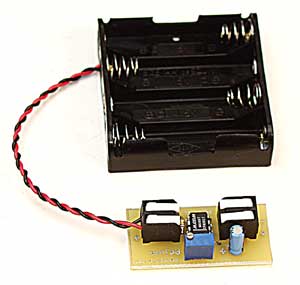|
Voltage regulators for electrical horology I am no longer making these regulators for sale.  Model 1 - Low current, high efficiency Model 1 - Low current, high efficiencyThe first style is designed to drive low power battery clocks like Bulle, Eureka, Brillie and ATO that run on 1-1/2 to 3 volts. Normally these clocks use either one or two battery cells. But the voltage changes as the batteries age, and the rate of the clock is likely to change as well. There are several benefits to driving one of these clocks with a regulated supply:
This circuit can supply up to 250 milliamps of power and the standby current draw is only about 20 microamps. This means the batteries will last a long time and not be drained by the regulator. 250 milliamps is plenty for the clocks mentioned above. Clocks that use more power, however, may overload this regulator. For example, a Synchronome is likely to require more current. The second style of regulator, shown below, is more appropriate for higher current clocks. The circuit has a 10-turn potentiometer for setting the voltage, allowing very fine adjustments. The output range is 1.25 volts to 6.5 volts. Higher limits are available on special request. It is small enough to fit easily inside the clock. Model 2 - Higher current with battery backup Regulation is accomplished with a small 10-turn potentiometer that will allow you to set the output voltage from 2.5 to 7.5 volts. The circuit also features a jack for a 9 volt backup battery in case the AC fails. This will keep the output voltage at the proper level (and keep the clock running) for short outages of the AC line. For greater protection against power outages you may want to supply a larger battery for the backup. For example, a 12 volt gel cell could be used. A 2.1 mm barrel jack is provided for input voltage from the AC adaptor. Solderless connectors are provided for the voltage output to your clock. A nine volt battery snap connector is provided for the backup source.
These items are no longer being made for sale.
Home | Horology | MicroSet | Clock circuits Voltage regulators | SlaveDriver | Governor | Semiconductor switch | EM controller
|
